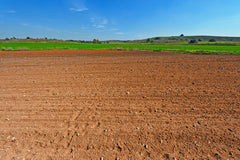
The first soil surveys conducted in the United States were completed during the 1920s. All of them reached the same conclusion: Our soil was depleted of key nutrients like nitrates and carbonates, which are necessary for the growth of healthy crops and, ultimately, nutrient-dense food.
And that was way back in the 1920s. The lack of nutrients in our soil has steadily worsened since then.
Not So Good Soil Interventions
Sure, some steps have been taken to improve the condition of our soil. In the 1930s and 40s, following the Great Dust Bowl, farmers planted soy as a cover crop to reinvigorate topsoil. (Soybeans are nitrogen-fixing, meaning they extract nitrogen from the air and convert it into compounds that other plants can use to grow.) During the late 1990s, local governments initiated soil rejuvenation programs, which also included the planting of soybeans. These programs helped to some extent but certainly not to the degree needed. Today, commercial agriculture routinely incorporates synthetic fertilizers made from petroleum into the soil to rapidly improve growth potential. While this practice does help grow crops, it doesn’t necessarily help grow
healthy crops. In fact, according to Dr. Donald R. Davis, a former research associate with the Biochemical Institute at the University of Texas, the increase in crop yield achieved by synthetic fertilizers has a nasty side effect: a
decrease in mineral content.
1 Even more troubling, synthetic fertilizers actually degrade the soil further by hastening the degradation of organic matter. Once that happens, the soil loses its ability to store nitrogen, so it’s actually
worse off than before the fertilizer was added! This creates the need for — you guessed it — more synthetic fertilizer. Not only that, when soil loses its organic matter, it starts to become more compacted. Soil compaction leads to soil erosion. And if enough soil erodes, you can wind up with another Dust Bowl scenario.
Overfed and Undernourished
This negative soil predicament has resulted in an overfed and undernourished population. In 2005, the United States Department of Agriculture (USDA) issued a report analyzing the adequacy of nutrient intake from food alone in the U.S. The percentage of Americans with inadequate nutrient intake from food is shocking and highlights the need to take supplements to ensure optimal nutrition:
- 93% have an inadequate intake of vitamin E
- 56% have an inadequate intake of magnesium
- 44% have an inadequate intake of vitamin A
- 31% have an inadequate intake of vitamin C
- 14% have an inadequate intake of vitamin B6
- 12% have an inadequate intake of zinc
- 8% have an inadequate intake of folate
Is Organic Food Good Enough?
So what about organic produce? Isn’t that a more nutritious choice? While I certainly encourage you to eat organic because it drastically reduces your exposure to pesticide residue, organic food isn’t necessarily nutrient-dense. Remember, our soil has been depleted of nutrients since the 1920s. All food — whether organic or conventional — is being grown in the same nutrient-deficient soil. Organic farmers do tend to practice more sustainable agricultural practices, such as planting cover crops, rotating crops, and adding compost to the soil. But these steps are not enough to overcome the poor condition of our soil.
What You Need to Know
It’s not fair that many of us are trying to stay healthier by eating better and exercising more only to find out our efforts are hampered by something out of our control — poor soil that is producing nutritionally poor food! But wait, you can do something about it — supplement your diet with vitamins, minerals, and antioxidants. The food you eat probably has just enough vitamins and minerals to prevent nutritional deficiencies but not enough to optimize your health. I suggest four foundational supplements for all of us: a multivitamin, healthy omega-3 fats, ubiquinol CoQ10 for cell energy, and probiotics for digestive health. This is a necessary step if getting healthier is your goal; food alone is just not enough today.
References:
-
HortScience. 2009 Feb;44(1).
 The first soil surveys conducted in the United States were completed during the 1920s. All of them reached the same conclusion: Our soil was depleted of key nutrients like nitrates and carbonates, which are necessary for the growth of healthy crops and, ultimately, nutrient-dense food. And that was way back in the 1920s. The lack of nutrients in our soil has steadily worsened since then.
The first soil surveys conducted in the United States were completed during the 1920s. All of them reached the same conclusion: Our soil was depleted of key nutrients like nitrates and carbonates, which are necessary for the growth of healthy crops and, ultimately, nutrient-dense food. And that was way back in the 1920s. The lack of nutrients in our soil has steadily worsened since then.
